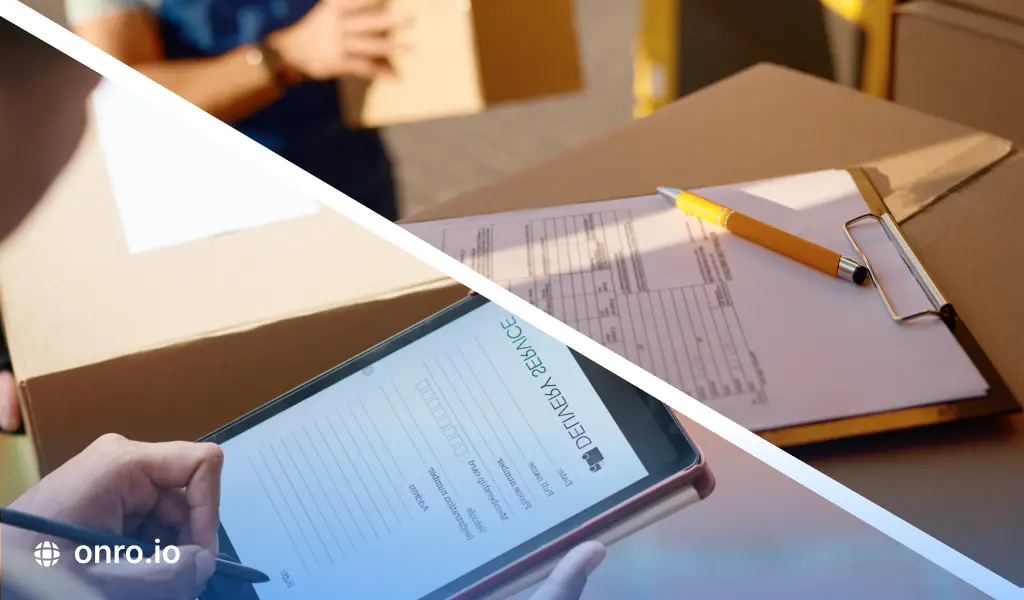Delivery management refers to the process of efficiently and effectively managing the delivery of products to customers. It involves the coordination of various tasks and activities, such as order processing, shipping, tracking, delivery, and customer service, with the ultimate goal of ensuring timely and accurate delivery while optimizing costs and improving customer satisfaction. Delivery management is critical for businesses that rely on timely and efficient delivery to meet customer needs and remain competitive in the marketplace. Businesses use delivery management software to manage their deliveries. In this article, we discuss the main challenges of the delivery management process.
Try Onro for Free
Get your free access to the Onro All-in-one Delivery Management Software.
Main Challenges of Delivery Management
Timely Delivery
Timely delivery refers to the successful completion of delivering goods within the expected or promised timeframe. It is the act of ensuring that products reach the customer or recipient within the designated delivery window or the agreed-upon schedule.
Timely delivery is a crucial aspect of customer satisfaction and plays a significant role in business success. Meeting delivery deadlines is important for several reasons:
- Customer satisfaction
- Trust and reliability
- Competitive advantage
- Operational efficiency
- Positive brand image
Cost Optimization
Cost optimization in delivery management presents challenges due to factors such as transportation expenses, inventory carrying costs, packaging and materials, labor and operational expenses, reverse logistics, technology investments, and fluctuating market conditions. Balancing cost reduction while maintaining service quality requires careful analysis, planning, and implementation of strategies such as optimizing delivery routes, selecting cost-effective carriers, streamlining processes, minimizing errors, and leveraging technology solutions.
Despite these challenges, businesses that effectively address cost optimization in delivery management can achieve significant savings, reduce delivery costs, enhance operational efficiency, and gain a competitive edge in the market.
Route Optimization
Route optimization can be challenging in delivery management due to several factors. It involves finding the most efficient routes that minimize distance, travel time, and fuel consumption while considering factors such as traffic conditions, delivery priorities, and vehicle capacities. Managing a large number of delivery locations, dynamic changes in route requirements, and optimizing routes in real-time can be complex. Additionally, balancing customer service requirements, cost considerations, and driver availability adds further complexity.
However, leveraging technology solutions can help overcome these challenges and enable businesses to optimize their delivery routes, reduce costs, and improve overall efficiency.
Communication
Communication can be challenging in delivery management due to the need for timely and accurate information exchange between various stakeholders. Effective communication involves providing customers with updates on order status, delivery times, and any potential delays or issues.
Coordinating with drivers, and other personnel involved in the delivery process requires clear and efficient communication channels. Utilizing communication tools such as automated notifications, real-time tracking systems, and dedicated customer support channels can help overcome these challenges and ensure smooth communication throughout the delivery process, enhancing customer satisfaction and operational efficiency.
Technology
Technology can present challenges in delivery management due to several factors. Implementing and integrating delivery management technologies, such as order management systems, tracking systems, and automation tools, may require initial investments and technical expertise. Businesses may face difficulties in selecting the right technology solutions that align with their specific needs and integrating them seamlessly into existing systems. Additionally, managing data security, privacy, and system reliability are crucial considerations. Keeping up with rapidly evolving technology trends and ensuring staff training and adoption can also be challenging.
However, overcoming these challenges by partnering with experienced technology providers can enable businesses to harness the benefits of technology, enhance delivery operations, and gain a competitive edge in the market. If you’re interested, you can explore our solution tailored to your business needs.
Try Onro for Free
Get your free access to the Onro All-in-one Delivery Management Software.
Customer Service
Customer service can pose challenges in delivery management as it requires meeting high customer expectations, providing effective communication throughout the delivery process, handling customer complaints and delivery problems promptly, accommodating customization and flexibility, and managing returns and exchanges efficiently. Businesses must prioritize customer service as a key aspect of their delivery management strategy, investing in robust systems, training staff, implementing clear communication channels, and continuously improving processes.
By delivering excellent customer service, businesses can enhance customer satisfaction, foster loyalty, and gain a competitive edge in the market.
Strategies for Optimizing Delivery Management
Automation and Technology
Automation and technology play a crucial role in optimizing delivery management. By leveraging automation and technology solutions, businesses can streamline processes, improve efficiency, and enhance the overall delivery experience. Automated order processing systems can expedite order fulfillment, reducing manual errors and processing time. Delivery management tools can optimize delivery routes, reducing fuel consumption and travel time.
Real-time tracking systems enable customers to track their deliveries and receive accurate updates, improving transparency and reducing customer inquiries. By harnessing automation and technology, businesses can optimize delivery management, reduce costs, improve customer satisfaction, and gain a competitive advantage.
Optimizing Routes
Route optimization is one of the essential components of delivery management that can significantly optimize the delivery process. Route optimization utilizes algorithms to calculate the most efficient routes for deliveries, taking into account factors such as distance and traffic conditions. By optimizing routes, businesses can minimize travel time and reduce fuel consumption, resulting in cost savings and improved efficiency.
Effective Communication
Effective communication plays a vital role in driving better delivery management. Clear and timely communication between all stakeholders involved, including customers, drivers, and dispatchers, ensures that everyone is well-informed and on the same page throughout the delivery process. By providing accurate and regular updates on order status, delivery times, and any potential delays or issues, effective communication helps manage customer expectations and build trust.
Real-time Tracking and Analytics
Real-time tracking and analytics play a crucial role in optimizing delivery management. Real-time tracking provides visibility into the location and status of deliveries, enabling proactive decision-making and efficient resource allocation. It enhances customer experience by allowing customers to track their shipments and receive timely updates. Analytics leverages data to generate valuable insights, such as delivery performance metrics and predictive models for demand forecasting and route optimization.
These insights enable businesses to streamline operations, improve efficiency, and reduce costs. By leveraging real-time driver tracking and analytics, businesses can make informed decisions, enhance customer satisfaction, and drive continuous improvement in their delivery management processes.
Some of the Best Practices in Delivery Management
Focus on Customer Experience
Focusing on customer experience can significantly improve delivery management by placing the customer at the center of the process. By prioritizing customer satisfaction and exceeding their expectations, businesses can enhance their delivery operations. This includes clear and timely communication, providing accurate delivery updates, offering flexible delivery options, and addressing customer delivery instructions, and concerns promptly.
A positive customer experience builds trust, loyalty, and positive word-of-mouth, leading to increased customer retention and brand reputation. Additionally, customer feedback and insights can be used to identify areas for improvement and implement necessary changes to optimize delivery management processes.
Leverage Technology and Automation
Leveraging technology and automation can significantly drive better delivery management in several ways. Firstly, technology solutions such as delivery management software, and real-time tracking platforms streamline and automate various aspects of the delivery process, improving efficiency and accuracy. Automation reduces manual errors, speeds up order processing, and enables seamless coordination between different stakeholders involved in the delivery chain.
Secondly, technology enables enhanced visibility and transparency, both for businesses and customers. Real-time tracking systems allow customers to track their shipments and receive updates, reducing customer inquiries and improving satisfaction. Technology and automation allow businesses to scale their delivery operations efficiently, accommodating increased demand and ensuring scalability without compromising on service quality.
Partnerships and Collaboration
Building strong partnerships with reliable carriers, logistics providers, and other stakeholders in the supply chain can lead to improved coordination, efficiency, and overall delivery performance. By collaborating closely with partners, businesses can leverage their expertise, resources, and networks to optimize delivery operations. This includes shared data, integrated systems, and joint planning to streamline processes, reduce costs, and enhance service levels.
Collaborative partnerships also enable businesses to tap into specialized services, expand their geographic reach, and meet customer demands more effectively. By working together, partners can identify and address operational challenges, share best practices, and drive continuous improvement in delivery management. Ultimately, partnerships and collaboration contribute to a seamless and customer-centric delivery experience, benefiting both businesses and their customers.
To Sum It Up
In summary, effective delivery management is essential for businesses to meet customer expectations, streamline operations, and achieve success in today’s competitive landscape. It encompasses various stages such as order processing, shipping, timely delivery, and customer service. To optimize delivery management, businesses need to focus on key areas such as cost optimization, route optimization, communication, technology adoption, and customer service. Leveraging technology, automation, and real-time tracking helps businesses enhance visibility, efficiency, and customer experience.
Originally published May 30, 2023 7:51 am, updated Wednesday, 12 June 2024.



